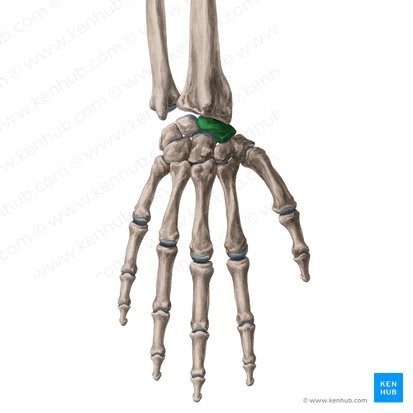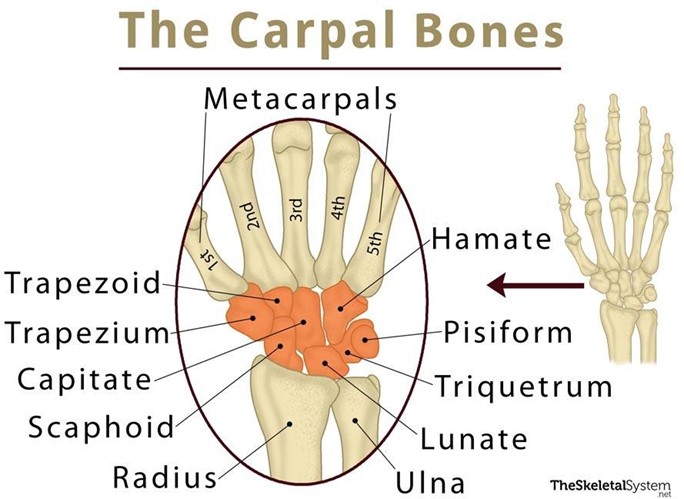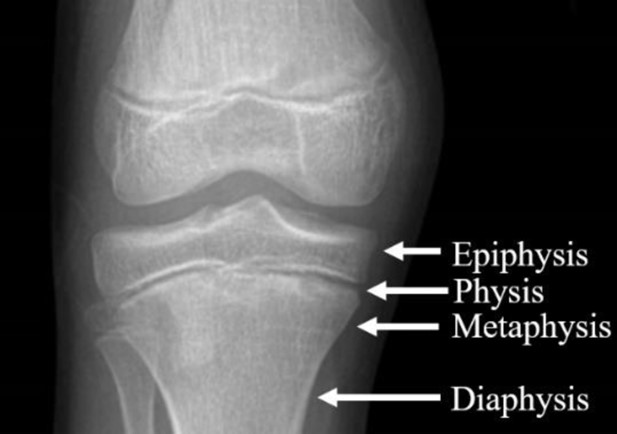Identify the bone in the diagram below

The Correct Answer is ["Scaphoid bone"]

The carpal bones, also known as the wrist bones, are a group of eight small bones located in the wrist joint.
They are arranged in two rows of four bones each, with the rows separated by a space known as the carpal tunnel.
The carpal bones are held together by ligaments, and their shape and arrangement allow for a wide range of wrist movements.
The names of the carpal bones, from the proximal row to the distal row, are the scaphoid, lunate, triquetrum, and pisiform, and the trapezium, trapezoid, capitate, and hamate.
Each bone has a unique shape and surface features that allow it to articulate with adjacent bones, forming a complex network of joints that are important for wrist and hand movements.
The carpal bones are important because they provide stability to the wrist joint, allowing for precise movements of the hand and fingers.
They also help to transfer forces from the hand to the forearm, and vice versa.
Injuries to the carpal bones can result in wrist pain, instability, and decreased function of the hand and fingers.
Additionally, the arrangement of the carpal bones can affect the function of the median nerve, which runs through the carpal tunnel.
Compression or irritation of this nerve can result in carpal tunnel syndrome, a condition characterized by pain, numbness, and tingling in the hand and fingers.
Nursing Test Bank
Naxlex Comprehensive Predictor Exams
Related Questions
Correct Answer is ["Scaphoid bone"]
Explanation

The carpal bones, also known as the wrist bones, are a group of eight small bones located in the wrist joint.
They are arranged in two rows of four bones each, with the rows separated by a space known as the carpal tunnel.
The carpal bones are held together by ligaments, and their shape and arrangement allow for a wide range of wrist movements.
The names of the carpal bones, from the proximal row to the distal row, are the scaphoid, lunate, triquetrum, and pisiform, and the trapezium, trapezoid, capitate, and hamate.
Each bone has a unique shape and surface features that allow it to articulate with adjacent bones, forming a complex network of joints that are important for wrist and hand movements.
The carpal bones are important because they provide stability to the wrist joint, allowing for precise movements of the hand and fingers.
They also help to transfer forces from the hand to the forearm, and vice versa.
Injuries to the carpal bones can result in wrist pain, instability, and decreased function of the hand and fingers.
Additionally, the arrangement of the carpal bones can affect the function of the median nerve, which runs through the carpal tunnel.
Compression or irritation of this nerve can result in carpal tunnel syndrome, a condition characterized by pain, numbness, and tingling in the hand and fingers.
Correct Answer is ["epiphyseal analysis"]
Explanation

The epiphysis is the rounded end of the femur that articulates with the hip bone and knee joint.
As a child grows, the epiphysis gradually fuses with the rest of the bone through a process called ossification.
By examining the degree of fusion of the epiphysis with the femur on an X-ray, doctors can estimate the age of the child.

In general, the younger the child, the less fused the epiphysis will be, and the easier it will be to determine the child's age.
However, it's important to note that this method provides only an approximate age range and cannot be used to determine an exact age.
Whether you are a student looking to ace your exams or a practicing nurse seeking to enhance your expertise , our nursing education contents will empower you with the confidence and competence to make a difference in the lives of patients and become a respected leader in the healthcare field.
Visit Naxlex, invest in your future and unlock endless possibilities with our unparalleled nursing education contents today
Report Wrong Answer on the Current Question
Do you disagree with the answer? If yes, what is your expected answer? Explain.
Kindly be descriptive with the issue you are facing.
